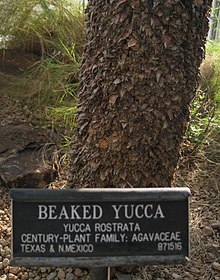en
names in breadcrumbs


Yucca rostrata [3] also called beaked yucca, is a tree-like plant belonging to the genus Yucca. The species is native to Texas, and the Chihuahua and Coahuila regions of Mexico. This species of Yucca occurs in areas that are arid with little annual rainfall. [4][5]
Yucca rostrata has a trunk up to 4.5 meters tall, with a crown of leaves at the top. Leaves are thin, stiff, up to 60 cm long but rarely more than 15 mm wide, tapering to a sharp point at the tip. The inflorescence is a large panicle 100 cm tall, with white flowers.[4][5][6]
As one of the hardiest trunk-forming yuccas, Yucca rostrata can be grown successfully outdoors down to USDA hardiness zone 5 and is popular in the Southwestern United States. The tree-like plant is commonly cultivated in El Paso, Texas, Albuquerque, New Mexico, Salt Lake City, Utah, and Denver, Colorado.[7][8][9]
Yucca rostrata also called beaked yucca, is a tree-like plant belonging to the genus Yucca. The species is native to Texas, and the Chihuahua and Coahuila regions of Mexico. This species of Yucca occurs in areas that are arid with little annual rainfall.
 Detail of the trunk
Detail of the trunk Yucca rostrata has a trunk up to 4.5 meters tall, with a crown of leaves at the top. Leaves are thin, stiff, up to 60 cm long but rarely more than 15 mm wide, tapering to a sharp point at the tip. The inflorescence is a large panicle 100 cm tall, with white flowers.